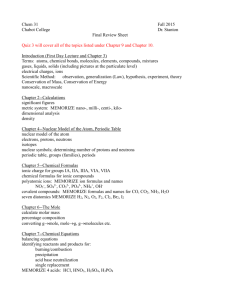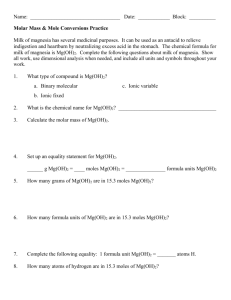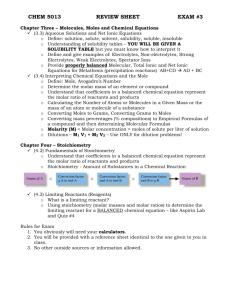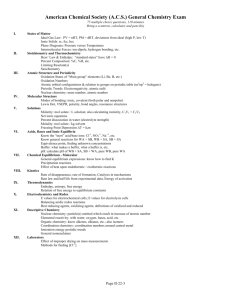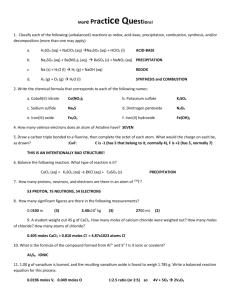Pointers Exam 2
advertisement
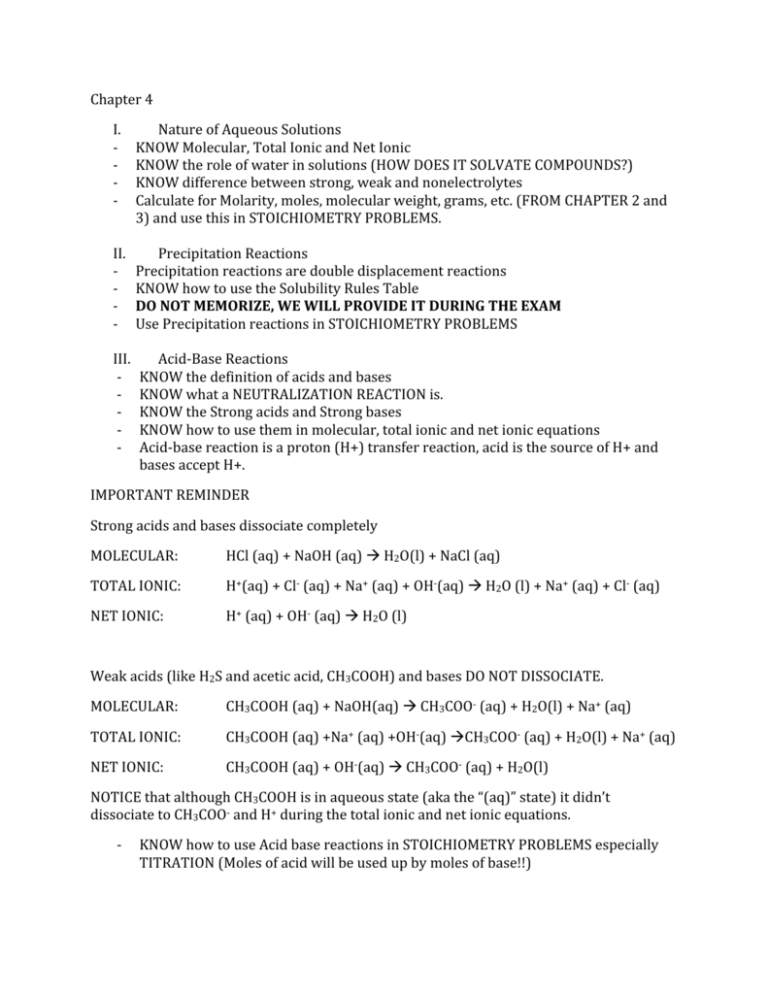
Chapter 4 I. ‐ ‐ ‐ ‐ II. ‐ ‐ ‐ ‐ III. ‐ ‐ ‐ ‐ ‐ Nature of Aqueous Solutions KNOW Molecular, Total Ionic and Net Ionic KNOW the role of water in solutions (HOW DOES IT SOLVATE COMPOUNDS?) KNOW difference between strong, weak and nonelectrolytes Calculate for Molarity, moles, molecular weight, grams, etc. (FROM CHAPTER 2 and 3) and use this in STOICHIOMETRY PROBLEMS. Precipitation Reactions Precipitation reactions are double displacement reactions KNOW how to use the Solubility Rules Table DO NOT MEMORIZE, WE WILL PROVIDE IT DURING THE EXAM Use Precipitation reactions in STOICHIOMETRY PROBLEMS Acid‐Base Reactions KNOW the definition of acids and bases KNOW what a NEUTRALIZATION REACTION is. KNOW the Strong acids and Strong bases KNOW how to use them in molecular, total ionic and net ionic equations Acid‐base reaction is a proton (H+) transfer reaction, acid is the source of H+ and bases accept H+. IMPORTANT REMINDER Strong acids and bases dissociate completely MOLECULAR: HCl (aq) + NaOH (aq) H2O(l) + NaCl (aq) TOTAL IONIC: H+(aq) + Cl‐ (aq) + Na+ (aq) + OH‐(aq) H2O (l) + Na+ (aq) + Cl‐ (aq) NET IONIC: H+ (aq) + OH‐ (aq) H2O (l) Weak acids (like H2S and acetic acid, CH3COOH) and bases DO NOT DISSOCIATE. MOLECULAR: CH3COOH (aq) + NaOH(aq) CH3COO‐ (aq) + H2O(l) + Na+ (aq) TOTAL IONIC: CH3COOH (aq) +Na+ (aq) +OH‐(aq) CH3COO‐ (aq) + H2O(l) + Na+ (aq) NET IONIC: CH3COOH (aq) + OH‐(aq) CH3COO‐ (aq) + H2O(l) NOTICE that although CH3COOH is in aqueous state (aka the “(aq)” state) it didn’t dissociate to CH3COO‐ and H+ during the total ionic and net ionic equations. ‐ KNOW how to use Acid base reactions in STOICHIOMETRY PROBLEMS especially TITRATION (Moles of acid will be used up by moles of base!!) ‐ Moles acid is not always equal to the moles of the base; this depends in the stoichiometry of the reactions!! Example 1. NaOH + HCl H2O + NaCl Moles HCl = Moles NaOH Example 2. 2KOH + H2SO4 2H2O + K2SO4 Moles H2SO4 = Moles KOH x 1/ 2 The 1/2 there is the stoichiometric ratio of KOH and H2SO4 IV. Oxidation‐Reduction Reactions ‐ KNOW What REDOX means (LEORA and GEROA) ‐ KNOW how to determine Oxidation numbers (MEMORIZE THE RULES!!) ‐ KNOW the different ways in which Redox can occur o Redox‐combination or Redox‐addition o Redox‐decomposition o Redox‐displacement Displacement of H2 from water or acid by metals • WE WILL PROVIDE YOU THE ACTIVITY SERIES, NO NEED TO MEMORIZE • KNOW how to use the activity series Displacement of Halogens (MEMORIZE!) o Redox‐combustion ‐ KNOW how to use Redox in STOICHIOMETRY PROBLEMS Chapter 5 I. Properties of Gas ‐ What differentiates it from liquids and solids? II. Measuring Pressure ‐ How do we measure gas? Barometer and Manometer ‐ Convert pressure 1 atm = 1.01325 barr = 760 mmHg = 760 torr = 14.7 psi = 101325 Pascals (MEMORIZE!!) III. Gas Laws ‐ KNOW Them o Boyle: P1V1=P2V2 in constant n and T o Charles/Gay‐Lusaac: V1/T1=V2/T2 in constant n and P o Amonton: P1/T1=P2/T2 changes in constant n and V o Avogadro: V1/n1=V2/n2 changes in constant P and T ‐ USE Them in COMBINATION! IV. Ideal Gas Law (IGL) and its applications ‐ KNOW the formula PV=nRT where R = 0.0821 L*atm/mol*K ‐ Use it in different applications o Getting density (m/V) o Getting molarity (n/V) o Getting MW o Dalton’s Law of Partial Pressures PTotal = P1 + P2 + P3… P1 = X1 PTotal where X1 is mole fraction of component 1 X1 = n1/ntotal NOTE if given in % volume as in problem set question # 5.41 treat % by volume as Volume occupied if the specific gas is set at the same pressure and Temp. A sample of air contains 78.08% N2, 20.94 % O2 and 0.05% CO2 and 0.93% Ar by volume. How man molecules of each gas is present in 1.00 L of sample at 25 degC and 1.00 atm. What does % by volume mean? It is the volume occupied of the specific gas if it was under the same pressure and temp So for N2: Ptotal V (of N2) = n(of N2) RT But we know V(of N2) = 0.7808 VTotal and VTotal = 1.00 L So we can get n(of N2) from this equation and eventually from moles to number of molecules! DO THE SAME FOR THE OTHERS. o KNOW how to use IGL in STOICHIOMETRY PROBLEMS V. KMT ‐ KNOW the Postulates (DO NOT JUST memorize! Make sure you ALSO UNDERSTAND IT!) ‐ How does it relate to Gas Laws o Relationship of pressures with no. molecules or volume or temperature o Temperature and KE and also speed of particles of different MW. VI. Real Gases ‐ Why do gases deviate from Ideal behavior ‐ van der Waals Equation (KNOW and understand the correction factors!) Chapter 6 I. ‐ ‐ Thermodynamics and Thermochemistry KNOW how to differentiate SYSTEM from SURROUNDINGS Some added info: o Open system – system can transfer both energy (in the form of heat and work) as well as matter (in the form of molecules/moles/mass) o Isolated System – system cannot transfer energy and matter o Closed system – system can transfer energy (in q and w) but not matter o Closed System with adiabatic boundary– system cannot transfer energy as heat, all energy is transferred as work. o Closed system with rigid boundary – system cannot transfer energy as work, all energy is transferred as heat. II. ‐ ‐ ‐ ‐ ‐ ‐ III. ‐ ‐ ‐ ‐ IV. ‐ ‐ ‐ ‐ ‐ V. ‐ ‐ VI. ‐ ‐ ‐ Internal Energy (and how it changes) What is Internal energy? What is a state function? Why can’t we measure exact values of internal energy? How is the change in internal energy of a system manifested? How is energy transferred? ΔE = q +w KNOW the SIGN CONVENTIONS o ΔE <0 = loss energy o ΔE >0 = gain energy o q < 0 heat lost o q > 0 heat gained o w < 0 work done BY system o w > 0 work done ON/TO system KNOW the FIRST LAW OF THERMODYNAMICS Enthalpy and Stoichiometry How is enthalpy related to internal energy (NO NEED TO MEMORIZE FORMULA just UNDERSTAND IT) WHAT IS ENTHALPY? ΔH = qp KNOW HOW Enthalpy works as a state function KNOW HOW Enthalpy works as related to chemical reactions. How do we use them in STOICHIOMETRY? Calorimetery What is Heat Capacity What is Specific Heat Capacity and Molar Heat Capacity? What does it mean if one object has a higher heat capacity than another? How is heat capacity used in calculating change in enthalpy of solutions? KNOW HOW TO USE THE COFFEE CUP CALORIMETER! o ΔHsys = q sys = –q surr = – m surr x c surr x ΔT surr o ΔHrxn = q rxn = –q soln = – m soln x c soln x ΔT soln Hess’s Law of Heat Summation WHAT IS HESS’S LAW? DERIVE the HEAT OF REACTION ΔHrxn based on the ΔH of other reactions Standard Heats of Formation What is the standard state? KNOW What is the Standard heat of formation ΔHf0? o Be able to write FORMATION REACTIONS! o KNOW THE STANDARD STATES OF COMMON ELEMENTS! State that is most stable at 1 atm and usually 25 deg C KNOW How can you use the ΔHf0 to calculate ΔHrxn0
